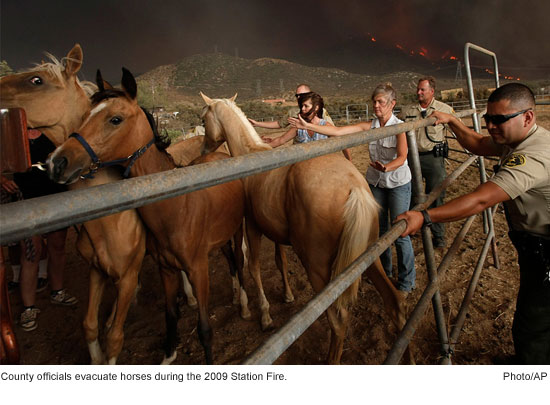Teaming up for all breeds of disaster
September 21, 2011
 People aren’t the only creatures who need help in a natural disaster—just ask the buffalo who was rescued from its backyard during the 2009 Station Fire. Or the zoo animals evacuated in 2007 when Griffith Park burned. Or any number of feline or canine survivors of the 1994 Northridge earthquake.
People aren’t the only creatures who need help in a natural disaster—just ask the buffalo who was rescued from its backyard during the 2009 Station Fire. Or the zoo animals evacuated in 2007 when Griffith Park burned. Or any number of feline or canine survivors of the 1994 Northridge earthquake.
For years, when Los Angeles County has needed help rescuing animals in peril, local municipalities and nonprofit animal welfare societies have willingly pitched in. The system has had just one problem, says county Directorof Animal Care and Control Marcia Mayeda: It hasn’t been official.
Now that situation is about to change, thanks to a mutual assistance agreement that spells out the framework under which the county and animal welfare groups will cooperate.
“No one has ever had a problem,” says Mayeda, “but over time, we began to realize that signing a formal Memorandum of Understanding might be good.” Although local agencies always responded gladly, she says, disasters elsewhere made it clear that potential liability questions and lines of communication could be clarified and federal reimbursement could be streamlined if a formal agreement were put in place.
This week, to the relief of Southern Californians of many species, the Board of Supervisors set the process in motion, approving an MOU with the Society for the Prevention of Cruelty to Animals Los Angeles.
Mayeda says the agreement, which lays out general lines of authority and resource sharing between the county and spcaLA, will help local officials respond to disasters more efficiently. Over time, she says, the department will ask other animal services agencies to sign on; the MOU can be expanded to include various humane societies and local animal control offices as co-signatories in times of need.
“There are about a dozen agencies like this that we’ve worked with in L.A.County,” she says. Cooperation is crucial, she says, because “a disaster or emergency knows no boundaries.”
“There aren’t a lot of us in the world who spend our time being concerned about the welfare of animals,” says Madeline Bernstein, executive director of spcaLA. “So we can get a lot more done when we help each other out in mutual aid.”
Bernstein says spcaLA has teamed up with the county informally on many occasions, manning shelters when county workers were out doing rescues, rounding up and dispersing food at pet evacuation centers, even joining forces with county investigators to help prosecute cases of animal cruelty.
During the Station Fire, she says, spcaLA helped the county feed and house countless animals who were rendered homeless by the conflagration near the Angeles National Forest.
“We had dogs, cats, birds, a very large pig, a llama they were trying to pull to safety,” she remembered. “A buffalo who was someone’s pet. We evacuated part of the Wildlife Way Station in conjunction with the county. In a disaster, there are all sorts of animals other than the ones you’d expect.”
Bernstein says Hurricane Katrina and other recent natural disasters spurred the move toward formalization.
“After Katrina, when we could see that people were choosing not to evacuate rather than to leave pets behind, it became clearer that a disaster plan should include animals,” she says.
“We have done exactly this forever,” says Bernstein. “This just puts forth a more organized face.”
Posted 9/21/11












 405 bridge work causes a stink
405 bridge work causes a stink
